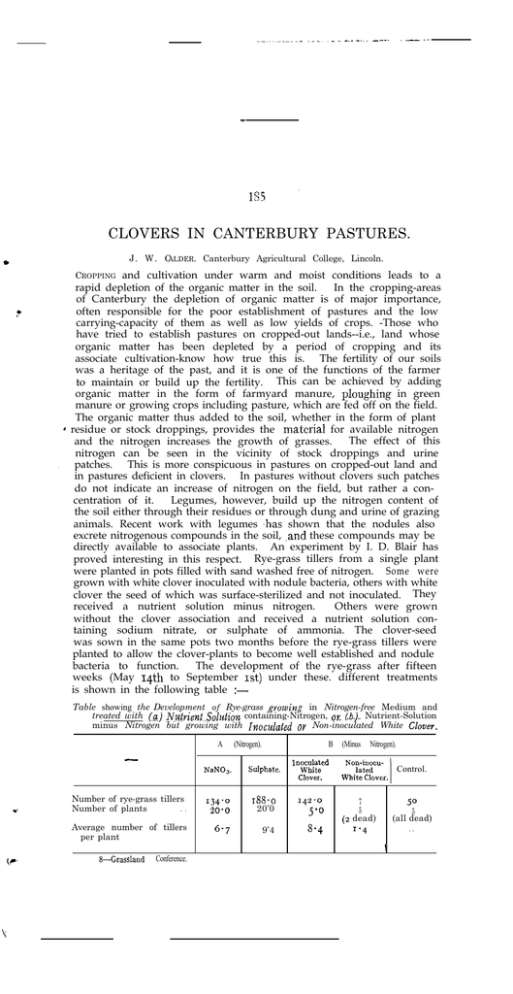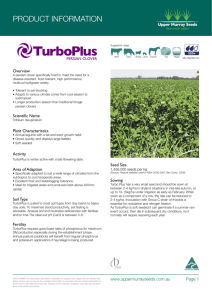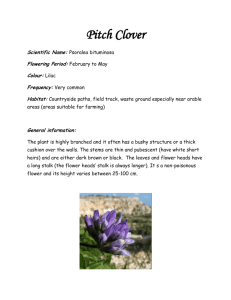CLOVERS IN CANTERBURY PASTURES.
advertisement

CLOVERS IN CANTERBURY PASTURES. J. W. CALDER. Canterbury Agricultural College, Lincoln. * and cultivation under warm and moist conditions leads to a rapid depletion of the organic matter in the soil. In the cropping-areas of Canterbury the depletion of organic matter is of major importance, often responsible for the poor establishment of pastures and the low carrying-capacity of them as well as low yields of crops. -Those who have tried to establish pastures on cropped-out lands--i.e., land whose organic matter has been depleted by a period of cropping and its associate cultivation-know how true this is. The fertility of our soils was a heritage of the past, and it is one of the functions of the farmer to maintain or build up the fertility. This can be achieved by adding organic matter in the form of farmyard manure, ploughing in green manure or growing crops including pasture, which are fed off on the field. The organic matter thus added to the soil, whether in the form of plant * residue or stock droppings, provides the material for available nitrogen The effect of this and the nitrogen increases the growth of grasses. nitrogen can be seen in the vicinity of stock droppings and urine . patches. This is more conspicuous in pastures on cropped-out land and in pastures deficient in clovers. In pastures without clovers such patches do not indicate an increase of nitrogen on the field, but rather a concentration of it. Legumes, however, build up the nitrogen content of the soil either through their residues or through dung and urine of grazing animals. Recent work with legumes ,has shown that the nodules also excrete nitrogenous compounds in the soil, .and these compounds may be directly available to associate plants. An experiment by I. D. Blair has proved interesting in this respect. Rye-grass tillers from a single plant were planted in pots filled with sand washed free of nitrogen. Some were grown with white clover inoculated with nodule bacteria, others with white clover the seed of which was surface-sterilized and not inoculated. They received a nutrient solution minus nitrogen. Others were grown without the clover association and received a nutrient solution containing sodium nitrate, or sulphate of ammonia. The clover-seed was sown in the same pots two months before the rye-grass tillers were planted to allow the clover-plants to become well established and nodule bacteria to function. The development of the rye-grass after fifteen weeks (May 14th to September 1st) under these. different treatments is shown in the following table :CROPPING f Table showing the Development of Rye-grass growin g in Nitrogen-free Medium and treated with (cz) Nutrient-Solution containing-Nitrogen, oc (Lb.)- Nutrient-Solution minus Nitrogen but growing with rnoculated OY Non-inoculated White Cbver. A (Nitrogen). B (Minus Nitrogen). NaN03. Sulphate. 1~;; 1 ;=JY2$f;r.) Number of rye-grass tillers Number of plants .. 134’0 20’0 188.0 20’0 142’0 5’0 Average number of tillers per plant 6.7 9’4 8.4 Control. 7 5 (2 dead) 1’4 50 5 (all dead) .. 1 8--Grassland P Conference. 186 _ This experiment indicates that white clover is capable of supplying nitrogen in an available form to rye-grass ‘growing in association with it, and suggests the importance of establishing clovers in pastures as early as possible. Nitrogen is made available in the soil for grass-growth from at least two important sources : (a) the organic matter-this does not increase the nitrogen-content of the soil unless it be from leguminous crops ; and (b) direct from growing legumes. The available nitrogen encourages vigorous grass-growth, and this when fed off adds to the organic matter in the soil, and the fertility of the soil is built up. Calculations of the amount of nitrogen added to the soil by clovers in pastures have been made, and the amount varies with the clover and *the soil conditions. In working with subterranean clover at the Waite Institute in South Australia, it was found the two successive crops of two tons each, if grazed, enriched the soil by approximately 108 lb. of nitrogen, equivalent to 54 cwt. of sulphate of ammonia. Think of this on our light land or on cropped-out fields . Nitrogen free of cost (or probably at the cost of annual dressings of superphosphate and lime) ; extra grass-growth ; extra stock grazed ; extra organic . matter ; extra fertility. There is naturally a limit to the improvement that can be made in the fertility by these means, but on some of the cropping lands of Canterbury that limit is worth aiming at. The general benefits of clovers in pastures are well recognized, and the majority of the mixtures sown contain clovers ; but how many on the cropping-lands of Canterbury are satisfied with the amount of clover that comes from the sowings, particularly in the first few years in the life of a pasture ? FACTORS INFLUENCING CLOVER CONTENT OF PASTURES, The first requirement is to sow the seed. This may appear to be an unnecessary statement, but it refers to white clover. Many pastures are sown without white clover, not because farmers do not appreciate the value of white clover, but because they have sown white clover and it has not established, or they have observed white clover coming into their pastures in the third or fourth years. They are content to rely on the so-called natural white clover in the land or that brought in by sheep. There is no doubt that there are areas where the land contains white-clover seed and this seed is likely to establish in a pasture, but there are thousands of acres on the plains where reliance on such The value of natural clover results in a clover-deficient pasture. establishing clover in the first year has been mentioned, and one can have a reasonable chance of achieving this object only by sowing the This, in itself, however, is not sufficient, and the other factors seed. which influence the growth of clovers must be considered also. The strain of clover sown has an important bearing on the clover content of the pasture. In the case of white clover the certified strains of New Zealand wild white clover have proved their own superiority for long-duration pastures over the ordinary commercial lines. In the case of red clover, it is well known that this valuable summer and autumn grower lasts only two years or so on the medium to light lands. The Montgomery red clover is a more persistent strain, and, while there are not many stands of this clover on the medium to light soils, the indications are that it will last one or two years longer on this class of land than the ordinary commercial red clovers, and is well ‘worth , i I 187 c i including in mixtures on such land. In regard to subterranean clover, from observations on some of the Australian strains and on the field establishment of some of the commercial lines it appears that strains more suitable for particular conditions can be isolated. A third factor of importance is lime. Soils without sufficient lime are usually sour, and sour soils do not grow clovers. A number of common weeds grow well on sour soils, particularly sorrel and spurry. It needs only a trip through Canterbury in summer-time to see the thousands of acres of red flowering sorrel which bear evidence to the sour condition on many areas. A certain degree of lime-deficiency does not necessarily restrict the growth of grasses and cereals, and the application of lime has not resulted in marked response to the growth of these plants in many areas in Canterbury, with the result that liming has not been widely adopted in Canterbury (8,000 tons in 1933-34, compared with 60,000 tons .for Southland). But on most soils in Canterbury a marked clover response is obtained. It is from this aspect that the liming must be considered. We must grow clovers in our pastures, and in order to achieve this object economically we must add lime. On pasture-lands up to I ton per acre can be put on as a foundation dressing. At Lincoln a pasture mixture was sown in December in a field. half of which had been limed twelve years ago at the rate of 2 tons of carbonate of lime per acre. The mixture consisted of 25 lb. of perennial rye-grass, 7 lb. of cocksfoot, 3 lb. of red clover, 2 lb. of wild white clover an acre, and I cwt. of superphosphate an acre is applied to the pasture in the autumn. In the first three years the effect of the lime, on the grasses was not noticeable, but the effect on the clovers was striking-both on red and white. An analysis of the pasture in the second autumn--i.e., when the pasture was fifteen months old4s given in the following table :Table showing the Effect of Lime afiplied Twelve Years previously on the Establishment of Clover sown in a Mixture. Pasture - Lime. Rye-grass . Cooksfoot . . Red Clover White Clover . . : . : : : : : Per cent. 60 5 20 I5 Fifteen I Months Old. No Lime. Per Cent. 90 5 To-day (July, 1936) there is little clover on the unlimed half, and the grass is winter-burnt and fibrous-looking, while on the limed half there is a good mixture of clovers and the grass is green and luscious. When sheep are turned on the plots they graze the clover sward in preference to that without clover. This trial demonstrates the lasting effect of a heavy initial dressing of lime under Canterbury conditions. The time of sowing also influences the amount of clover in our pastures. Clover seedlings are frost-tender. In the second- and thirdleaf stage they are subject to frost-lift, particularly when the ground is wet, and therefore the seed should be sown early enough for the . 188 plants to become well established before the heavy frosts set in. Nearly all our clovers are sown with rye-grass, which is a vigorous grower in its early life and may soon form a smother to retard the development of the associate clovers. When sown by itself clover will establish well on a good seed-bed as late as the end of March, but when sown with rye-grass as late as this the rye-grass establishes well, but the vigorous rye-grass retards the development of the clover, which is then subject to frost-lift. In a monthly sowing trial conducted at Lincoln a mixture of rye-grass, cocksfoot, and red and white clovers was sown at the beginning of each month from October to April. I n the following autumn counts ‘were made of the number of red-clover plants in each sowing, and the results are given in the following table :--’ -Table showing the Effects of Tinae of Sowing on the Establishment sown with Rye-grass. Red Clover when Average Number of Red-clover Plants per Square Yard. Date of Sowing. October-December . . January-February . . March-April . . . of .. .63 1: 2 16 Now, many of our pastures in Canterbury are sown in March after a ‘cereal crop, and it is suggested that this late sowing is frequently one of the major factors responsible for paucity of clover in the pastures, although the rye-grass may establish perfectly well even though sown as late as May. The ability of the rye-grass to establish in the late autumn often disguises the poor establishment of the clover-s, and it is not until the second autumn that the absence of clovers is noticed. Once having got clover established in the pasture by a combination of the factors mentioned-sowing the seed, sowing the right kind of clover, liming the ground, and sowing early--the amount of clover, particularly white clover, may be influenced The clover is a poor by the grazing and manurial treatment. winter grower, and starts growth later in the spring. than does rye-grass. When the pasture is spelled in winter and early spring the rye-grass gets a start on the clover and suppresses it to some extent. Conversely, when pastures are grazed closely in winter and early spring, the close grazing prevents a dense rye-grass smother and gives the white clover a chance to develop, and may even allow too much clover to develop. Some of our pastures are subject to this treatment, especially where supplementary crops are a failure or not available. When the close grazing in early spring is associated with liming and autumn top-dressing with superphosphate, too much clover may develop. Farmers who get too much clover are indeed fortunate. They have the fertility building element. They can now proceed to reduce the amount of clover by encouraging the growth of grass by spelling in early spring and by applying soluble nitrogenous fertilizers. But, with the permanent strains of rye-grass and with intelligent manuring and grazing-management, too much clover will not be a common complaint in Canterbury pastures. . Y 189 DISCUSSION. 6 Mr. Marshall : I think farmers do not fully realize the value of organic matter in the soil. We have trouble in establishing clover. In the north of South Canterbury and in quite a considerable area of Mid-Canterbury the white clover comes naturally, and it is not sown in mixtures as it ought to be. ‘Up to the present time we have been using the white clover that is harvested in most instances on weak stubble. This clover undoubtedly is smothered by a strong growth of grass in the spring, but in the case of the stronger-growing types of white clover such is definitely not the case. I have always found Montgomery comes away as early as rye-grass and keeps the winter-green in pastures. The better the clover-bottom in the pasture the more stock you can carry. There is definitely a swing now to the use of more lime in Canterbury-very much so in South Canterbury. The effect of liming for the establishment of clover I think is generally realized by farmers. In South Canterbury we have had wonderful success in sowing red clover in the spring on wheat. In the autumn we get wonderful feed from it, and it grows we11 into the winter and comes away earlv in the spring-it must be treated with superphosphate. That involves one of the biggest points : the farmers must keep their fertility high to retain the high-grade pastures. Mr. HoZmes : Ked clover is now being appreciated on some of the large holdings in Canterbury. It has been found the better system to maintain five or six paddocks cut for hay, that hay being fed out in the bale, the experience being that half-bred sheep winter better on hay than they do on turnips. Possibly a mixed ration of the two would be better, but the general management of the farm points to the utilization of hay as the most economic proposition. It should also be remembered that red clover is of very considerable importance in the South Island. The necessity of sowing white clover is now being realized by farmers in the South. The old idea of allowing the white clover to come in by itself is now being reversed. Mr. Flay : The establishment of clovers is one of the problems that is in the mind of every progressive farmer on the Canterbury Plains to-day. So much is it a problem that some Canterbury farmers have actually given up sowing cloversthey sow rye-grass alone. Because we are sowing true perennial rye-grass, which is less palatable than clovers, we get a grazing factor : because the clovers are relatively more palatable in the early stages than the rye-grass they are eaten out before they actually have an opportunity of being established. This factor is one of the most important in the development and maintenance of clovers, even though you may get a fair strike. It is brought into prominence, by the fact that farmers have been encouraged to sow true perennial rye-grass. Mr. Chamberlain : In Marlborough the importance of lime in clover establishment is probably more outstanding than anything else. On the rolling country of Seddon and Ward our perennial rye-grass is unsatisfactory : clover is not sown because it is thought it will fail, and therefore rye-grass alone is sown. The actual fact is that the soil is deficient in lime. In Marlborough, towards the Fairhill district, there are large areas of land carrying danthonia. interspersed with great clay patches. Subterranean clover sown on some of this country promptly took and the practice is rapidly spreading. The clover is a bright, vivid possession, green right up to the boundaries of the man who has not sown it. In the paddocks that have been sown longest there is a definite invasion of English grasses coming through the subterranean clover. They have not been sown there, but the fertility is increasing so much that they arc just “ coming in.” On the first farm where it was sown there are areas which are now carrying subterranean clover as the dominant species with rye-grass and cocksfoot. Mr. Staffoord : I am quite sure that while the clover content is an important factor there is something else, of which we know little, that is preventing the establishment of good pastures in Canterbury. Whether it is the rainfall or the bad distribution of the rainfall, I do not know. -






